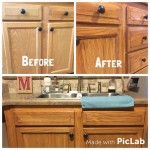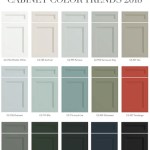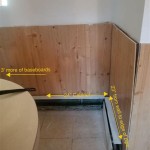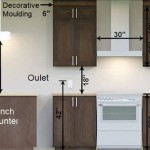Shine a Light on Style: Inside Kitchen Cabinet Lighting Ideas
Kitchen cabinet lighting elevates both the functionality and aesthetics of a kitchen space. It provides crucial task lighting for food preparation while also highlighting decorative elements and creating ambiance. Choosing the right type of lighting and placement can transform the overall look and feel of the kitchen.
Types of Inside Cabinet Lighting
Various lighting options exist to suit different cabinet styles and desired effects. Understanding the advantages and disadvantages of each type helps in making an informed decision.
- Puck Lights: These small, disc-shaped lights offer focused illumination and are ideal for highlighting specific objects within cabinets. They are easy to install and available in various color temperatures.
- Linear Strip Lights: LED strip lights offer a sleek and modern look, providing continuous illumination along the underside of cabinets. Their flexibility allows them to be installed in various shapes and sizes, making them suitable for both straight and curved cabinet designs.
- Tape Lights: Similar to strip lights, tape lights are highly flexible and can be cut to fit specific cabinet lengths. They are discreet and provide even lighting distribution.
- Shelf Lighting: Illuminating shelves directly enhances visibility and adds depth to the cabinet space. Shelf lighting can be integrated into the shelf itself or mounted underneath.
- Rope Lights: Offering a softer, more ambient glow, rope lights work well for accentuating the edges of cabinets or creating a decorative border. They are available in various colors and can add a touch of personality to the kitchen.
Placement Strategies for Optimal Illumination
Strategic placement of cabinet lighting maximizes its effectiveness and enhances the overall kitchen design.
- Under Cabinet Lighting: This is the most common placement, providing direct light onto countertops for improved task lighting during food preparation.
- Inside Cabinet Lighting: Illuminating the interior of cabinets makes it easier to find items and adds depth and visual appeal. This is particularly useful for glass-front cabinets.
- Above Cabinet Lighting: Lighting placed above cabinets washes the ceiling with light, creating a sense of height and adding ambient illumination to the kitchen.
Choosing the Right Color Temperature
Color temperature plays a crucial role in setting the mood and ambiance of the kitchen.
- Warm White (2700-3000K): Creates a cozy and inviting atmosphere, ideal for traditional kitchens.
- Cool White (4000-5000K): Provides a brighter, more energizing light, suitable for modern kitchens and task-oriented areas.
- Daylight (5000-6500K): Mimics natural daylight, offering excellent visibility for detailed tasks. This is a good choice for areas where color accuracy is important.
Power Source Considerations
Cabinet lighting can be powered in several ways, each with its own set of benefits and drawbacks.
- Battery-Powered Lights: Easy to install and requiring no wiring, battery-powered lights are a good option for renters or those looking for a quick and simple solution. However, batteries need regular replacement.
- Plug-in Lights: These lights plug into standard outlets, making them relatively easy to install. However, visible cords can detract from the overall aesthetic.
- Hardwired Lights: Offering a more permanent and streamlined solution, hardwired lights require professional installation but provide a cleaner, more integrated look.
Dimmable Options for Enhanced Control
Dimmable cabinet lighting offers the flexibility to adjust the brightness level according to the time of day and desired ambiance. This feature allows for customized lighting scenarios, from bright task lighting to soft, mood lighting.
Smart Lighting Integration for Modern Convenience
Integrating smart lighting technology into kitchen cabinets provides a high level of control and customization. Smart lights can be controlled remotely via smartphone apps, allowing users to adjust brightness, color temperature, and even set schedules. Some smart lighting systems also integrate with voice assistants for hands-free operation.
Enhancing Aesthetics with Cabinet Lighting
Beyond its functional benefits, cabinet lighting significantly impacts the aesthetics of the kitchen. It can highlight decorative elements, create visual interest, and enhance the overall design style.
- Highlighting Glassware and Dishware: Illuminating glass-front cabinets showcases beautiful glassware and dishware, turning them into decorative features.
- Creating a Focal Point: Strategic lighting can draw attention to specific areas of the kitchen, such as a backsplash or a unique architectural detail.
- Adding Depth and Dimension: Cabinet lighting adds depth and dimension to the space, making the kitchen feel larger and more open.
Energy Efficiency and Cost Savings
LED lighting is the most energy-efficient option for kitchen cabinets, consuming significantly less energy than traditional incandescent or halogen bulbs. This translates to lower electricity bills and a reduced environmental footprint. LED lights also have a longer lifespan, reducing the frequency of replacements and associated costs.

Inside Glass Cabinet Lighting How To Installing

How To Light A Kitchen Lightology

9 Best In Cabinet Lighting Options And Ideas

Inside Cabinet Lighting Modern Kitchen Houston By Gb General Contractors Houzz

8 Bright Accent Light Ideas For Your Kitchen

Kitchen Cabinet Lighting Ideas For Your Home Design Cafe

10 Best Kitchen Lighting Ideas For Low Ceilings Carla Bast Design

Kitchen Cabinet Lighting Ideas For Your Home Design Cafe

How Important Is Kitchen Cabinet Lighting

40 Kitchen Lighting Ideas To Brighten Your Space
Related Posts








